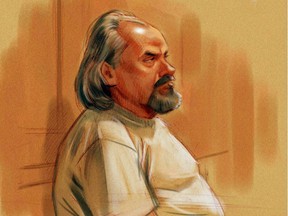Blood of two victims found on Borutski's clothing, forensic scientist testifies

Article content
OTTAWA - Basil Borutski was wearing the blood of two of his victims when he was arrested following a Sept. 22, 2015 killing rampage through Renfrew County, according to Crown testimony as his triple-murder trial resumed Tuesday.
Following an eight-day break in the trial, prosecutors Jeffery Richardson and Julie Scott called forensic scientist Camilla Sewhdat, who told the jury her team of investigators at Toronto’s Centre of Forensic Sciences matched DNA lifted from Borutski's bloodstained clothing with samples drawn from two of the women killed that day.
Borutski remained silent, his head bowed and eyes closed, refusing to acknowledge the court while representing himself at his trial on three charges of first-degree murder in the killings of Carol Culleton, 66, Anastasia Kuzyk, 36, and Nathalie Warmerdam, 48.
Sewhdat testified that Borutski’s denim shirt was stained in several places with blood matching Culleton’s.
Borustki admitted in a police interrogation he beat Culleton and strangled her to death with a television coaxial cable at her Kamaniskeg Lake cottage near Combermere, then drove her car to kill Kuzyk at her home in Wilno and Warmerdam, who lived near Cormac, with a shotgun.
A single bloodstain found on the top of the brim of Borutski’s Tilley hat was matched with Warmerdam’s.
No DNA evidence linking Borutski to Kuzyk or the Wilno crime scene was entered in court.
When the first of the 54 exhibits submitted to the agency was received and catalogued in October, 2015, investigators were not given Borutski’s name, and knew only that Profile 1 belonged to a male. That profile was later identified as Borutski’s using a sample of blood collected by warrant and sent under seal to the CFS in April 2017.
The forensic team used blood drawn from each of the victims during autopsies as comparison samples, and found positive matches with two of the “unknown DNA profiles” discovered on Borutski’s clothing, which he was wearing during his arrest and was later sent to the CFS.
“When a known DNA profile is compared to a sample from an evidentiary item, we conclude the person cannot be excluded if the known and the unknown profile is from the same source,” Sewhdat testified. “The only other explanation is the known and unknown profile are the same by coincidence.”
The agency calculated that coincide, or “random match probability”, placing the odds at one in 67 quadrillion that DNA contained in the blood on Borutski’s shirt belonged to someone other than Culleton, whose DNA was found on crime scene evidence.
Forensic investigators found blood matching Culleton’s on the lower sleeves, front panels, and on a button on the cuff of the long-sleeved denim shirt Borutski wore that day.
Borutski’s own DNA traces were left on a cigarette butt discarded in Culleton’s sink, and were identified on the envelope flap of the nine-page handwritten letter he mailed to Culleton’s North Gower home on the eve of her killing. Similar evidence was also lifted from the envelope flap of a handwritten letter delivered three days after the killings to Borutski’s probation officer in Pembroke.
His DNA was also lifted from swabs of a water bottle recovered by police.
Sewhdat on Tuesday identified each of those items, which have all previously been entered into evidence during the trial, as Richardson showed them to the jury.
Investigators also lifted DNA evidence matching Borutski’s profile from swabs of blood discovered on the centre console and interior front door of Culleton’s car.
The car was found near a hunt camp on Becks Road following Borutski’s arrest in a nearby Kinburn field, hours after the killings on the afternoon of Sept. 22, 2015.
The shotgun found in a nearby bush was sent to the CFS for examination, but yielded “no DNA profile suitable for comparison,” Sewhdat said.
Under brief cross-examination from amicus James Foord — appointed by the court to ensure Borutski’s right to a fair trial — Sewhdat acknowledged the DNA testing “does not determine” the time or the manner in which blood might be deposited onto an evidentiary item.
The trial resumes Wednesday, with the Crown expected to be nearing the conclusion of its case against Borutski.
ahelmer@postmedia.com
Twitter.com/helmera